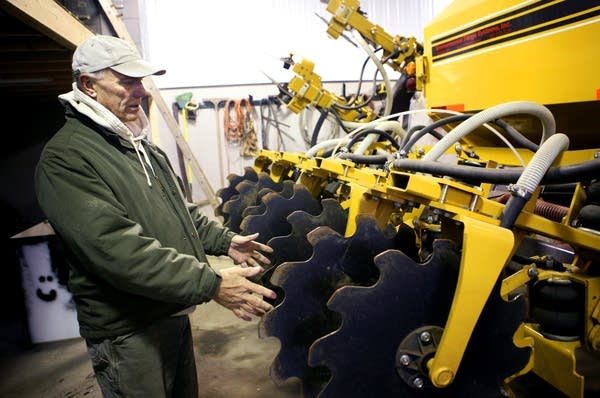Sediment from farm runoff poses a threat to Lake Pepin
Go Deeper.
Create an account or log in to save stories.
Like this?
Thanks for liking this story! We have added it to a list of your favorite stories.

In a deep tree-lined gorge far below St. Paul's busy streets, the mighty Mississippi River meets the muddy Minnesota.
"What you can see is two distinctly-colored bodies of water meeting: the relatively clean Mississippi and the relatively dirty Minnesota, which is loaded with sediments," said Paul Labovitz, superintendent of the Mississippi National Rivera and Recreation area.
About 40 miles downstream, those sediments reach Lake Pepin, a wide spot in the Mississippi. About 20 miles long, it runs from Red Wing to Wabasha. Early explorers described it as crystal clear, with "the best fish in great abundance," and "covered with water-fowl."
But these days, the water flowing into Lake Pepin is a milky brown, and the lake is filling up with mud. The river is depositing about 10 times as much sediment as it did before white settlers came to Minnesota.
Turn Up Your Support
MPR News helps you turn down the noise and build shared understanding. Turn up your support for this public resource and keep trusted journalism accessible to all.
Lake Pepin, on Minnesota's southeastern border, is choking on sediment, according to the Minnesota Pollution Control Agency. The upper third of the scenic lake in the Mississippi could be filled in over the next 100 years. An MPCA draft report cites farm runoff as a major cause, but state officials have little leverage to compel changes that could save the lake.
The sediment in Lake Pepin affects not only the water quality, but animal life. Without clean gravel river beds, fish will lose their spawning habitat. Mussels that rely on a clean river bottom will disappear. Even insects are at risk.
"The whole food chain is affected when you cover the bottom of a river with silt and sediment," Labovitz said. "Then it fills in, and it's no longer a river. It might just become a stagnant wetland, and ultimately will become dry land."

Scientists say the silt will fill in the upper seven miles of the lake by the end of this century.
What makes this problem especially difficult to solve is that about three-quarters of the sediment comes from farm country, where federal water rules don't reach. Because the pollution comes from many different sources, finding a solution will be difficult.
"There's no federal regulation that's going to drive it," said Norman Senjem, the chief author of a major study by the Minnesota Pollution Control Agency. "It's up to the state of Minnesota."
A CHANGED LANDSCAPE
According to the study, most of the sediment doesn't come directly from farm fields, but rather from stream banks. Over the years, farmers have thoroughly re-directed water flows to keep their fields dry. As a result, water now rushes out of ditches and into rivers too fast, eventually winding up in the Minnesota, the Mississippi, and Lake Pepin.
"We need to change the landscape in such a way that less water from the sky gets into the streams, to reduce the energy in those streams and the scouring out of sediment that that causes," Senjem said.

The MPCA is proposing goals to reduce sediments, but is leaving for another day the question of how to make that happen. Senjem said the job is likely to fall to local government.
Counties are responsible for water quality. They generally rely on voluntary conservation efforts, such as programs that pay farmers to rebuild wetlands. So far, those programs have not persuaded enough farmers to make a difference.
The government cannot compel farmers to slow down the flow of water leaving their land. Farmers do face penalties if they plow under a wetland. But other than that, asking farmers to control their water flow is just that -- asking. And it means asking them to accept smaller profits.
Many farmers are careful to prevent erosion by leaving grass buffer strips near water bodies, and even in fields. They use tilling techniques that leave crop residues on the surface, preventing erosion and compaction, and holding moisture in the soil. They are starting to use flow control structures in their drainage ditches to hold back water after the fields are dry enough to plant.
Near Northfield, for example, farmer David Legvold uses new equipment manufactured in Minnesota that slices the soil in a narrow strip, disturbing it as little as possible. Such new technologies work well with the precision farming techniques that help farmers boost production on each acre of land.
But such practices have not been adopted by enough farmers to counter the growing sediment problem.

THE ECONOMICS OF DRAINAGE
In Renville County, where Larry Zupke has the unenviable job of maintaining ditches, there are 3,500 miles of drainage pipes installed under the soil. Those pipes drain into nearly 800 miles of ditches -- more than miles of roads in the county. Nearly all of the ditches drain into the Minnesota River.
Farmers often plow right up to the lip of the ditch. Sometimes the plowing itself throws soil into the ditch. In most cases, it would be better to leave a strip of grass along the edge of the ditch to slow the flow of water and catch sediment from the field, Zupke said.
But Zupke said there is a potential downside to the grass buffer: Soil is more likely to collapse and wind up in the ditch because it hodls so much moisture.
Zupke would like to see a flexible set of rules to prevent erosion. His top wish is for the banks on many ditches to slope more gently. But he knows that would be a hard sell to some farmers, because they'd lose that land for planting.
Even giving up land for a grass buffer can be a hard sell, Renville County Commissioner Lamont Jacobson said.

"One of the guys called me right away and boy he wasn't going to give up, because he figured out it was two acres he'd be losing, and he just can't give up two acres," Jacobson said. "They probably have 1,500 or 2,000 acres. They say they can't afford it, but they're just stubborn, they just don't want to do it."
State law only requires buffer strips alongside ditches when major work is done or there's a formal economic review of a ditch. Counties don't have to do either.
Tom Kalaher, a conservation technician with the Renville County Soil and Water Conservation District, said counties would have a better chance of limiting runoff if Congress changed the Farm Bill to encourage conservation practices.
He said the nation's farm program grossly favors production of corn and soybeans over protection of the environment.
"If you look at what's spent on the conservation side, nationally, and what's spent on the commodity side, the imbalance is horrific," Kalaher said. "Until that changes, the results to the environment are going to be the same as what we've been seeing the 40 or 50 years."
Meanwhile, the voluntary efforts to protect the water don't seem to be helping much. A new study from the Minnesota Pollution Control Agency says aquatic life in the Minnesota River and its tributaries has not improved significantly in the last 20 years.
Read part two of this series, which explains what is causing sediment to choke Lake Pepin.






